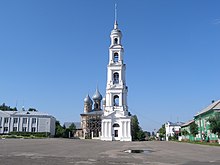Yuryevets
| city
Yuryevets
Юрьевец
|
||||||||||||||||||||||||||||||||||||||||||
|
||||||||||||||||||||||||||||||||||||||||||
|
||||||||||||||||||||||||||||||||||||||||||
| List of cities in Russia | ||||||||||||||||||||||||||||||||||||||||||
Jurjewez ( Russian Юрьевец ) is a city in the Ivanovo Oblast ( Russia ) with 10,210 inhabitants (as of October 14, 2010).
geography
The city is located about 170 km northeast of the Oblast capital Ivanovo on the right bank of the Volga, which is dammed up here to form the Gorkier Reservoir .
Jurjewez is the administrative center of the raion of the same name .
history
The city was founded in 1225 by the Vladimir-Suzdal prince Juri Vsevolodowitsch (also Georgi) and named after him Jurjew-Powolschski ( Jurjew on the Volga to distinguish between Jurjew-Polski and Jurjew-Livonsky , today Tartu ). The name Georgievsk was also used.
As early as 1237, the city was captured and destroyed by the troops of Batu Khan , but recovered again.
From 1405 Yuryev-Powolschski belonged to the Principality of Gorodets , from 1448 to the Grand Duchy of Moscow , from 1451 to Suzdal , before she finally came to Moscow. In 1565 the city was overwritten by Ivan IV the Oprichnina . The city name in its current form has been common since around this time.
During the turmoil at the beginning of the 17th century, Jurjewez was attacked several times by Polish troops. A stone fortress was built between 1661 and 1663 and lasted until the end of the 18th century.
In 1778 Jurjewez received the modern town charter as the administrative center of a district (Ujesds).
Population development
| year | Residents |
|---|---|
| 1897 | 4,776 |
| 1926 | 9,300 |
| 1939 | 15,508 |
| 1959 | 19,746 |
| 1970 | 20,144 |
| 1979 | 18,273 |
| 1989 | 16,535 |
| 2002 | 12,664 |
| 2010 | 10.210 |
Note: census data (1926 rounded)
Culture and sights
Although the flooding of the Gorkier Reservoir in the 1950s, the strongly meandering rivers Usta and Njomda, which flow into the Volga on the opposite side, disappeared under the water level with their floodplains, their mouths are now over 15 kilometers from the city and that is The appearance of the area has thus fundamentally changed, Yuryevets is still one of the most picturesque small towns on the Volga.
In the city center are the Old and New Cathedral of the Entry of Christ in Jerusalem ( Входоиерусалимский собор / Wchodojerussalimski sobor) from 1806 and 1825 to 1833, the Epiphany Church ( Богоявленская церусаленская цер-ковсковь the beginning of the 18th century. Church ( Рождественская церковь / Roschdestvenskaja zerkow) from 1815.
Beyond the river port lies the so-called White City , remains of the fortress from 1661 to 1663.
The city has a local history museum , the Museum of the City Yuryevets , a brothers-Wesnin Museum and Andrei Tarkovsky-Museum .
Economy and Infrastructure
In Yuryevets there is a linen weaving mill founded in 1871, as well as wood processing and food industries.
The city lies on the road R81 Kineschma -Jurjewez- Puchezh -Purech (at Zavolzhye ).
Personalities
- Andrei Tarkowski (1932–1986), film director; born in the village of Zavrashye in Yuryevets Raion, spent part of his childhood in Yuryevets
- Arseni Tarkowski (1907–1989), poet, father of Andrei Tarkowski; lived temporarily in Yuryevets
- Alexander Wesnin (1883–1959), architect; born in Yuryevets
- Wiktor Wesnin (1882–1950), architect; born in Yuryevets
The Wesnin brothers created or designed (often together, also with their older brother, Leonid Wesnin , who was born in Nizhny Novgorod ; 1880–1933) significant structures in the style of Constructivism , before they switched to “Stalinist” neoclassicism in later years ( DneproGES , Palast of the Soviets ).
Web links
- Rajon and City Administration website (Russian)
- Private website about the city (Russian)
- Jurjewez on mojgorod.ru (Russian)
Individual evidence
- ↑ a b Itogi Vserossijskoj perepisi naselenija 2010 goda. Tom 1. Čislennostʹ i razmeščenie naselenija (Results of the All-Russian Census 2010. Volume 1. Number and distribution of the population). Tables 5 , pp. 12-209; 11 , pp. 312–979 (download from the website of the Federal Service for State Statistics of the Russian Federation)




